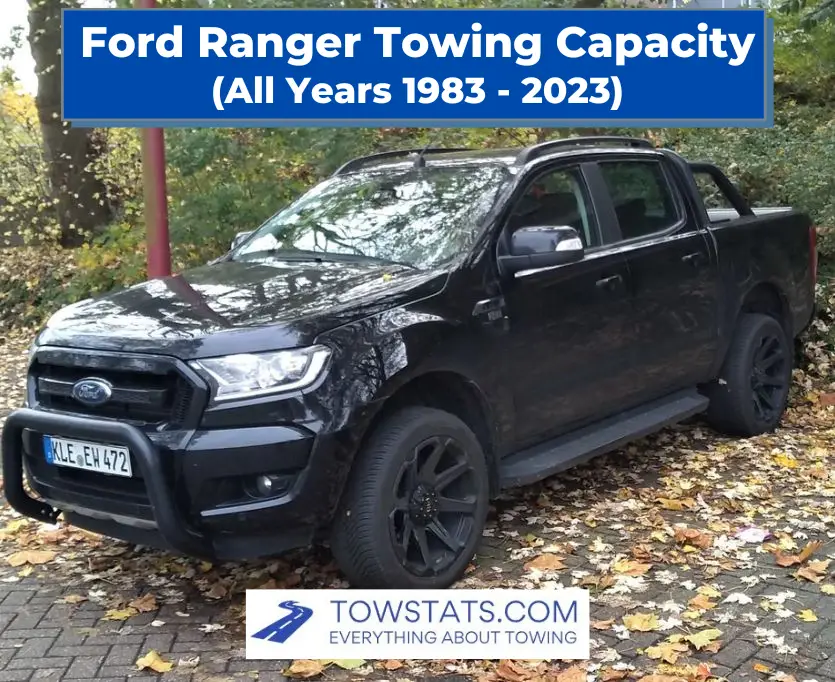The Ranger was introduced into Ford’s truck lineup as a compact pickup truck in 1983 and remains available today. Ford trucks are known for their reliability and for having the features consumers expect from today’s vehicles, including towing. But what is the towing capacity of a Ford Ranger?
The Ford Ranger has a maximum towing capacity of 7,500 pounds. This number depends heavily on the configuration and model year.
There’s a bit more to know about Ford Ranger towing capabilities which we’ll cover in today’s guide.
Ford Ranger Towing Capacity By Year
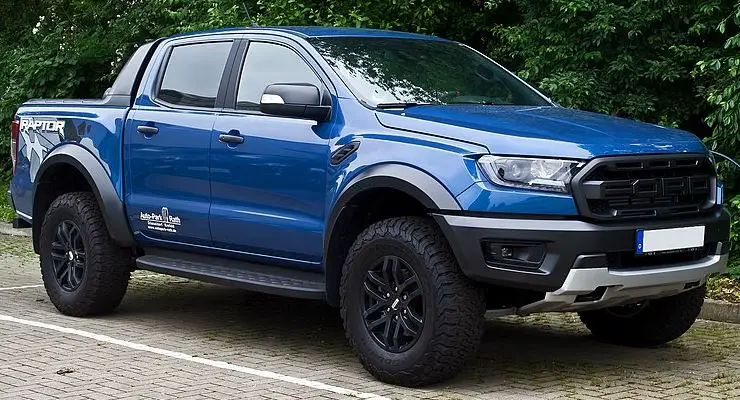
As we covered earlier, the current Ford Ranger can tow a maximum of 7,500 lbs when properly equipped.
The Tundra has been in production from 1983 through the present other than 2012 through 2018, and we’ve listed out the maximum tow capacity by year below for reference.
Note that for each model year, there are many variables that affect the total towing capability of each vehicle year, so we recommend checking your specific Titan vehicle year for an in-depth guide and to get the most accurate information.
Here are the Toyota Tundra max tow capacity by year:
2023 Ford Ranger Tow Capacity: 7,500 pounds
2022 Ford Ranger Tow Capacity: 7,500 pounds
2021 Ford Ranger Tow Capacity: 7,500 pounds
2020 Ford Ranger Tow Capacity: 7,500 pounds
2019 Ford Ranger Tow Capacity: 7,500 pounds
2011 Ford Ranger Tow Capacity: 5,800 pounds
2010 Ford Ranger Tow Capacity: 5,940 pounds
2009 Ford Ranger Tow Capacity: 5,860 pounds
2008 Ford Ranger Tow Capacity: 6,000 pounds
2007 Ford Ranger Tow Capacity: 6,000 pounds
2006 Ford Ranger Tow Capacity: 6,000 pounds
2005 Ford Ranger Tow Capacity: 5,860 pounds
2004 Ford Ranger Tow Capacity: 5,980 pounds
2003 Ford Ranger Tow Capacity: 5,960 pounds
2002 Ford Ranger Tow Capacity: 6,020 pounds
2001 Ford Ranger Tow Capacity: 6,070 pounds
2000 Ford Ranger Tow Capacity: 6,060 pounds
1999 Ford Ranger Tow Capacity: 6,000 pounds
1998 Ford Ranger Tow Capacity: 6,000 pounds
1997 Ford Ranger Tow Capacity: 6,000 pounds
1996 Ford Ranger Tow Capacity: 6,000 pounds
1995 Ford Ranger Tow Capacity: 6,000 pounds
1994 Ford Ranger Tow Capacity: 6,000 pounds
1993 Ford Ranger Tow Capacity: 4,500 pounds
1992 Ford Ranger Tow Capacity: 5,800 pounds
1991 Ford Ranger Tow Capacity: 5,900 pounds
1990 Ford Ranger Tow Capacity: 5,800 pounds
1989 Ford Ranger Tow Capacity: 5,600 pounds
1988 Ford Ranger Tow Capacity: 5,600 pounds
1987 Ford Ranger Tow Capacity: 5,600 pounds
1986 Ford Ranger Tow Capacity: 5,600 pounds
1985 Ford Ranger Tow Capacity: 5,600 pounds
1984 Ford Ranger Tow Capacity: 5,600 pounds
1983 Ford Ranger Tow Capacity: 5,800 pounds
You can also read our guide on what makes a vehicle towing capacity to learn all the aspects that go into it.
Here’s a video showing the Ford Ranger being put to a real-world off-road and towing test:
Ford Ranger Braked Vs. Unbraked Towing Capacity
All vehicles have different towing capacities based on whether or not you’re towing a trailer that has trailer brakes installed.
Trailer brakes allow the trailer to stop faster than if only the vehicle is using its brakes, allowing the vehicle to tow more weight, so braked towing capacity will always be higher than unbraked towing capacity.
Ford Ranger Braked Towing Capacity: 3,500 lbs. – 7,500 lbs.
Ford Ranger Unbraked Towing Capacity: 1,500 lbs.
Ford Ranger Towing Capacity Factors
There are a few factors that affect the Ford Ranger tow capacity.
Engine Options
The tow capacity of your Ford Ranger largely depends on which engine it has in it.
We break this down in the Ranger tow capacity by year charts later in this guide.
Tow Package Installed
A big factor in how much weight the Ford Ranger can tow is whether Ford’s towing package is installed.
For example, on the most recent model years having the towing package installed can more than double the tow capacity!
Generation and Model Year
The towing range of Ford Ranger trucks seemed to follow a trend for a certain number of years, then it would shift as new engines or other enhancements were changed out in the lineup.
We’ll cover this later in our guide.
Number of Passengers
A big factor in calculating your vehicle’s towing capacity is how many passengers you’re carrying, which directly calculates into the vehicle’s GCWR.
This is true of all vehicles, not just the Ford Ranger, so always take into consideration the total load of your passengers and gear in addition to what you’re towing.
Ford Ranger Engine Specs
The current generation of the Ford Ranger has a single engine option.
2.3 Liter 4-Cylinder EcoBoost Engine
The most current Ranger engine is a 2.3 Liter I-4 EcoBoost engine.
This engine produces 270 hp and 310 lb.-ft of torque, paired with a 10-speed automatic transmission.
Ford Ranger Tow Packages
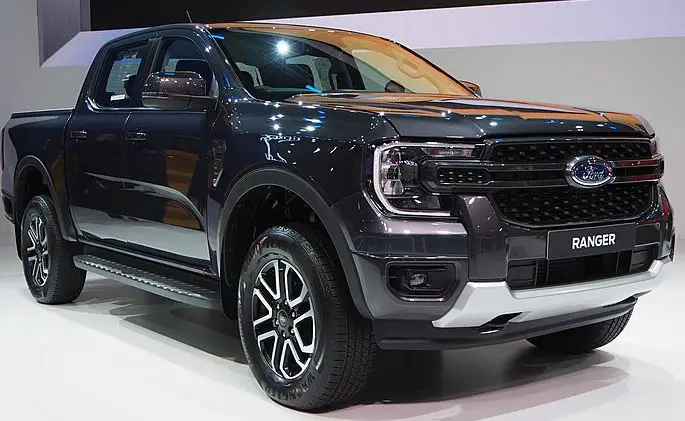
Does The Ford Ranger Have A Tow Package?
Ford offers a tow package (option code 53R) that is available on all trim levels of the current model year Ranger.
The Ford Ranger towing package (53R) includes the following:
- Class III tow hitch receiver
- 4 and 7-pin connector with converter
- Trailer Module
- Tow/Haul Mode
- Trailer Sway Control
Can You Install A Trailer Hitch On a Ford Ranger?
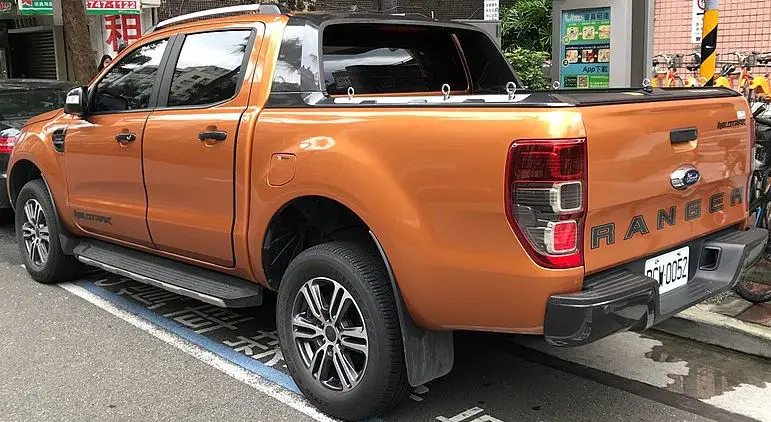
If you plan on towing anything with your Ford Ranger, you’ll need a tow hitch and wiring harness.
Depending on what you’re towing, you’re going to need a ball mount (aka a trailer ball hitch) so you can attach items for towing.
Make sure to get the right trailer ball size that matches your hitch and trailer.
Ford Ranger Tow Hitch
Trailer hitches come in different hitch classes, which are rated for different vehicle sizes and weight limits.
The Ford Ranger uses a Class 3 hitch.
Here’s a great option for a Class III Ford Ranger trailer hitch:
- DEPENDABLE STRENGTH. This trailer hitch is rated for 4,000 lbs. gross trailer weight, 400 lbs. tongue weight, 6,000 lbs. weight distribution capacity and 600 lbs. weight distribution tongue weight (limited to lowest-rated towing component)
- VERSATILE DESIGN. This class 3 hitch equips your vehicle with a standard 2-inch x 2-inch hitch receiver, allowing for a wide variety of towing options. It can accept a ball mount, cargo carrier, bike rack, tow hook and much more
- FULLY TESTED. Every CURT class 3 trailer hitch design is tested in real-world, on-vehicle conditions at our Detroit engineering facility. Aftermarket hitches are tested according to SAE J684 standards for the utmost safety while hauling
- RUST, CHIP, UV-RESISTANT. This tow hitch is protected with a unique dual-coat finish of rust-resistant liquid A-coat and highly durable black powder coat. The two finishes are co-cured together for exceptional resistance to rust, chipping and UV rays
- EASY TO INSTALL. This hitch offers a custom, factory fit on select model years of the Mazda B2300, B3000, B4000 and Ford Ranger
Here’s a great ball mount option so you can hook up different types of trailers for towing with your Ranger:
- DEPENDABLE STRENGTH. Rated to tow 3,500 pounds gross trailer weight and 350 pounds tongue weight, this ball hitch offers dependability for your towing setup (weight capacity may change if trailer ball is removed)
- VERSATILE USE. This trailer hitch ball mount comes with a 1-1/4-inch shank to fit virtually any industry-standard 1-1/4-inch receiver. The ball mount has a 3-1/4-inch drop, 2-inch diameter ball, 1/2-inch hitch pin hole and 7-1/4-inch overall length
- READY TO TOW. Hitching up your trailer is easy with this ready-to-use trailer hitch ball mount. It comes with a pre-attached tow ball for ready coupling and a trailer hitch pin to securely mount onto your hitch receiver
- CORROSION-RESISTANT. For long-lasting use, this ball hitch is protected with a durable black powder coat finish, and the trailer ball has a polished chrome plating. These finishes resist damage from rain, dirt, road salt and other corrosive threats
- EASY TO INSTALL. To install the trailer hitch ball mount on your vehicle, simply insert the shank into your vehicle's 1-1/4-inch hitch receiver. The rounded shank makes installation easy
Ford Ranger Tow Hitch Installation
If you’re considering having a tow hitch added to your Ranger, expect to pay between $100 and $200 to have a tow package professionally installed (excluding the cost of the tow hitch and wiring harness).
If you’re handy and looking to save money, you can install the trailer hitch and wiring harness yourself.
Always follow the manufacturer’s directions and use proper safety precautions.
Here’s a great video walkthrough on a Ford Ranger trailer hitch installation:
Hitch Receiver Vs Rear Step Bumper Towing
Some vehicles allow for bumper towing, which means you can mount a tow hitch ball directly on the bumper instead of installing a tow hitch to the vehicle’s frame.
Can I Bumper Tow With A Ford Ranger?
The Ford Ranger does not allow for bumper towing, so you’ll need to use a frame-mounted hitch.
How Do I Know If My Ford Ranger Has A Tow Package?
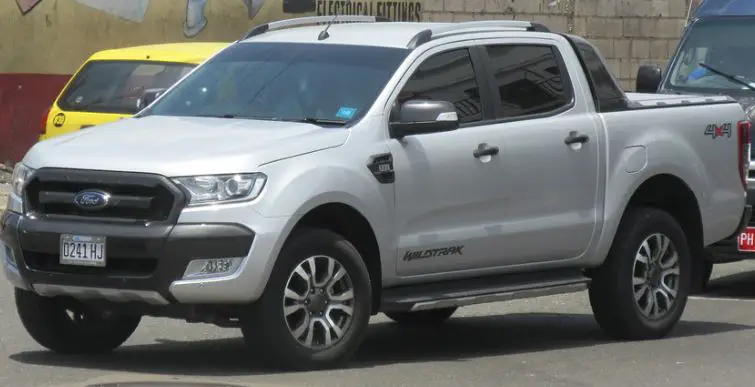
You can start by looking under the rear bumper of your Ranger to see if you notice a trailer hitch or trailer ball.
That will give you a good indication of if you have a tow hitch already installed on your Ranger.
Another way to research this is by checking the paperwork that came with your vehicle or taking it to a local dealer to see what’s installed.
Make sure to have your VIN (Vehicle Identification Number) handy if you call the dealer so they can look up the exact specs and whether or not your vehicle has any towing packages or features installed on it.
Ranger Towing Stats By Model Year and Generation
5th Generation: 2023 and Beyond
The 5th generation Ford Ranger will have the same 7,500 pound max tow capability as the prior generation.
Although it is getting a complete redesign, the Ranger will be sticking with the same powertrain that was in the 2019-2022 models, which is the 2.3L EcoBoost I-4 engine.
There also may be a hybrid engine added to the lineup, but this wouldn’t surpass the 7,500 pound tow capacity of the 2023 Ford Ranger.
4th Generation (T6): 2019 – 2022
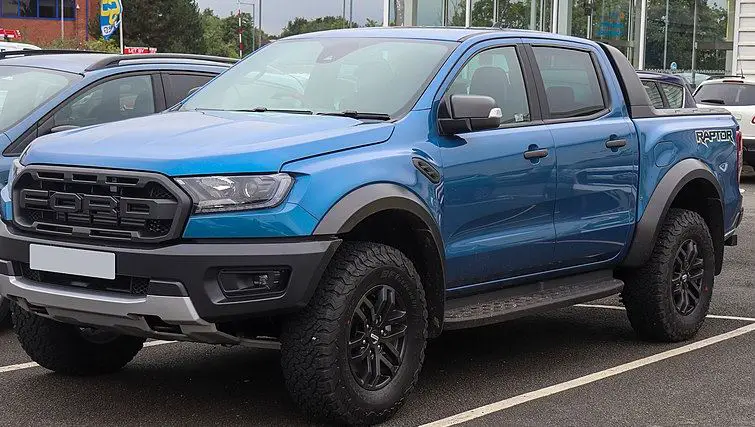
The 4th generation Ford Ranger had a max tow range of 3,500 lbs to 7,500 lbs, and came in the XL, XLT, and Lariat trim levels.
All had the same 2.3L EcoBoost I-4 engine, which is the same engine that will be used for the 2023 model.
The Ranger was reconfigured as a mid-size pickup in 2019 to help it better compete against the Toyota Tacoma and Chevy Colorado.
In 2020, the FX2 package was introduced for off-roaders, which gave it a newly tuned suspension and an electronic locking rear-differential.
In 2021 they added the Black appearance package which included a black grill and black wheels.
In 2022, the Splash appearance package was added for the XLT and Lariat trim levels, which featured black and orange body graphics and a retro 90s look.
3rd Generation: 1998 – 2012
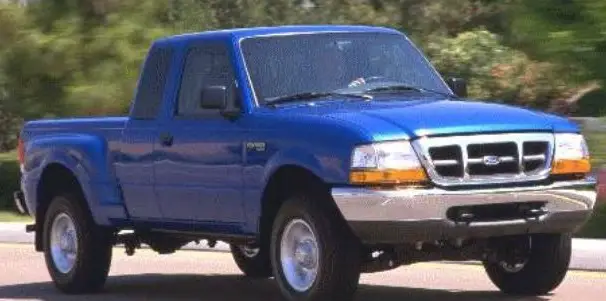
This is a pretty broad range in terms of years, so we’ll break it down a bit further.
The 2002-2011 Ford Rangers with the 2.3L engine in XL, XLT, Sport, and Splash trims had a towing capacity of 1,340 lbs to 2,295 lbs, which was much lower than the 4th generation models.
The 2004-2008 XL, XLT, Sport, Edge, and Splash trims with a 3.0L V6 engine had a tow capacity of 2,240 lbs to 2,660 lbs.
The 2000-2003 XL, XLT, and Edge trims with a 3.0L V6 engine had a towing range of 2,200 lbs to 4,160 lbs.
The 2000-2011 Ford Rangers in all trims (XL, XLT, Sport, FX4, STX, Edge, Splash) with a 4.0L V6 engine had a tow capacity of 2,000 lbs to 6,070 lbs.
The 2000 and 2001 Ford Rangers (XL and XLT) that had a 2.5L engine could pull between 1,360 lbs and 2,195 lbs.
Lastly, the 2000 Ford Ranger models that had a 5.0L engine could tow between 5,620 lbs and 6,820 lbs.
The third generation Ranger came with a big overhaul that extended the wheelbase and cab, but left the interior portion mostly untouched.
The I-4 engine was increased over the previous generation from 2.3L to 2.5L and increased the output to 117 hp. There were also 3.0L V6 and 4.0L V6 engines made available.
In 2001, Ford added a 4.0L V6 with 207 hp to replace the prior V6 and added ABS to the 2WD Ranger models.
These changes afforded a 6,000 towing capacity on some Ranger configurations.
2004 brought a new hood, bumper, and grill, plus options for leather upholstery and a CD player.
In 2007 there were options for anti-theft, tire-pressure monitoring, and other enhancements, but none of those are relevant to the tow rating.
2rd Generation: 1993 – 1997
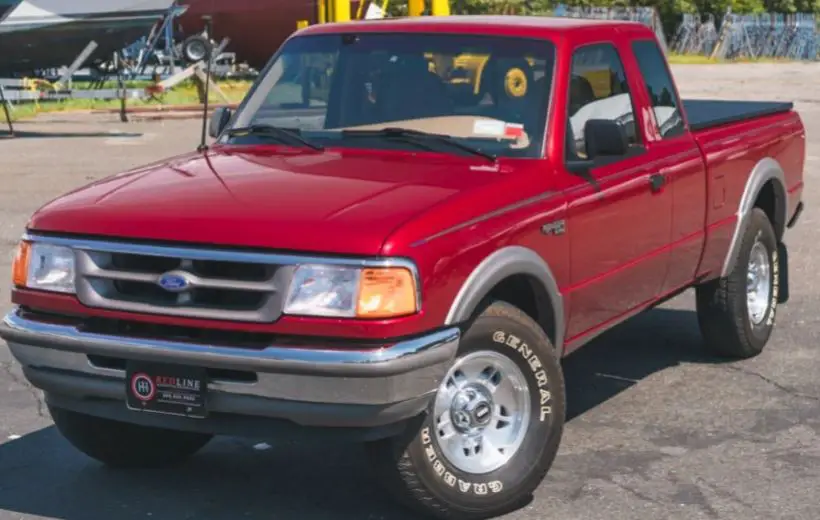
Ford introduced the second generation of the Ranger in 1993 with a body redesign.
There were three engines available: a 2.3L I-4 with 98 horsepower, a 3.0L V6 with 145 horsepower, and a 4.0L V6 with 160 horsepower.
In 1995 the Ranger got an increase of 112 horsepower and upgraded transmission.
1st Generation: 1983 – 1992
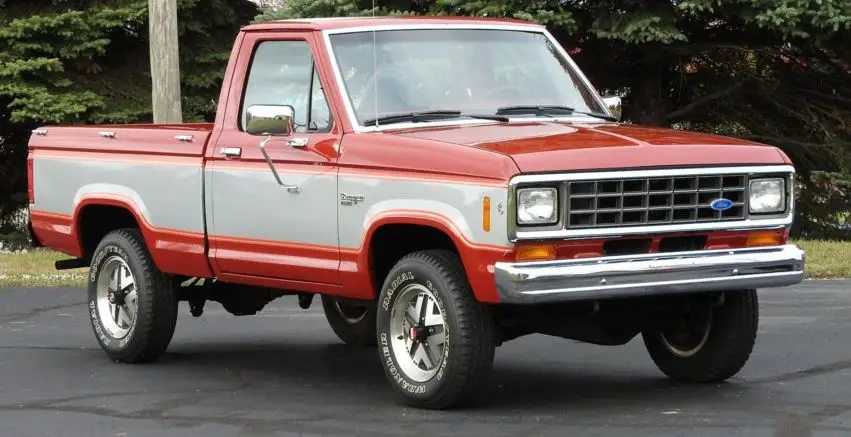
The first generation ranger replaced the Mazda-built Courier, and came available in 4×4 or RWD, with two bed size and wheelbase options to select from.
The 1983 4×4 Ford Ranger had a towing capacity of 1,600 pounds.
There were three gas engine options: a 2.0L 4-Cylinder with 73 horsepower, a 2.3L 4-Cylinder with 79 horsepower, a 2.8L V6 with 115 horsepower.
There were also 2 diesel engine options: initially it was a 2.2L Diesel with 59 horsepower built by Mazda, but after 1985 it was switched to a 2.3L Turbo Diesel built by Mitsubishi.
In 1986, the Ranger got a 2,9L fuel-injected V6 with 140 horsepower, and the introduction of the SuperCab.
In 1989, the Ranger had some miscellaneous improvements, but the main event was a new base 2.3L 4-Cylinder engine which produced 100 horsepower and the option of a manual or automatic transmission.
The 1989 Ford Ranger 4×4 had an option for a 4.0L V6 engine with 160 horsepower.
In 1991, the Ford Ranger Sport trim was introduced, giving the option of a 3.0L V6 140-hp engine on 2WD models.
Data Accuracy
We’ve gathered all data represented here from the official Ford Ranger Owner’s Manuals on Ford’s site and have checked all data thoroughly for accuracy.
Having said that, we still recommend you refer to your vehicle’s owner’s manual yourself before towing with a Ford Ranger.

